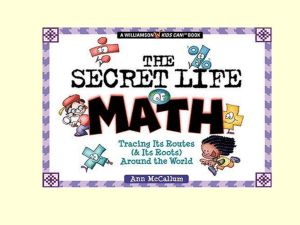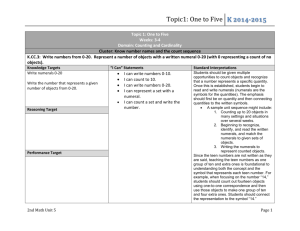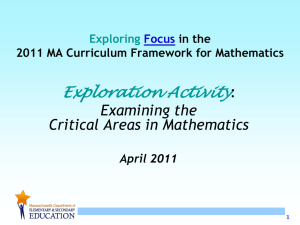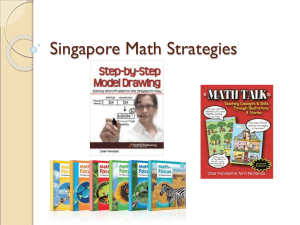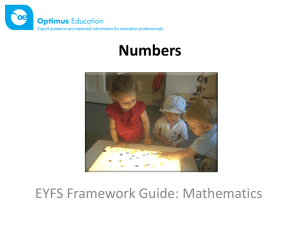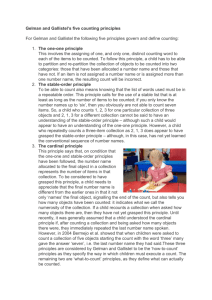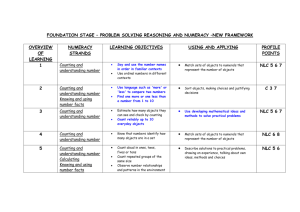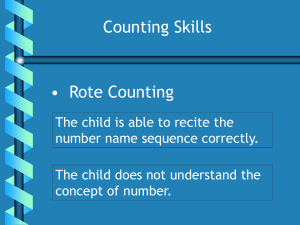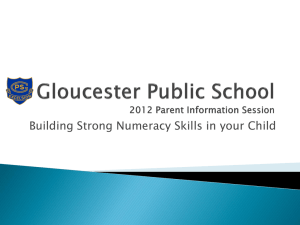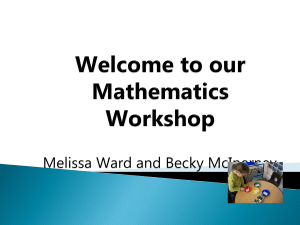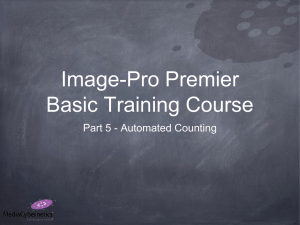Counting workshop part 2 student version
advertisement
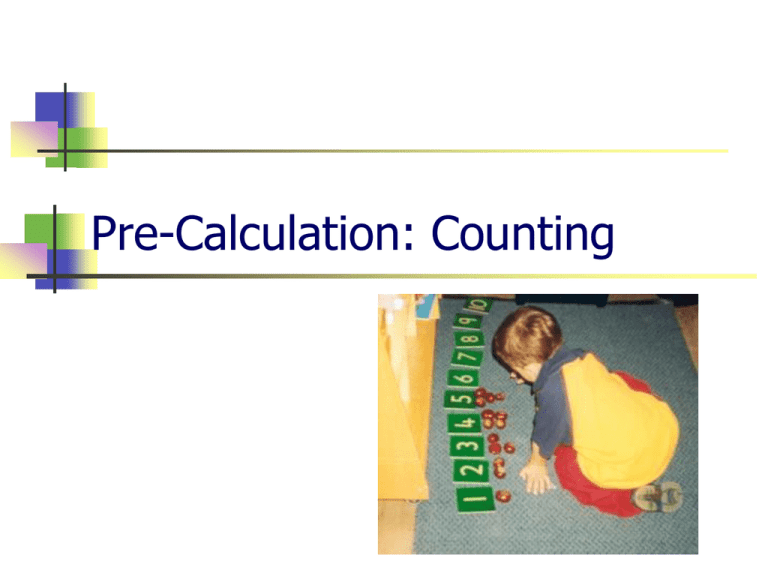
Pre-Calculation: Counting Learning Objectives By the end of the session students will: recognise the developmental stages in learning to count; relate EYFS curriculum to appropriate learning activities for children; be familiar with approaches to counting; be aware that recording (numerals) with young children should be within a meaningful context (including mark-making). What is Number? Numbers in Everyday Life – at home….. Counting Labelling Counting Principles The one-one principle: There is a distinct counting word to match each of the items counted. The stable-order principle: The list of words must be consistent. The cardinal principle: The final word tells us how many there are in the number of items counted. The abstraction principle: You can count any collection of objects whether real or imaginary. The order irrelevance principle. It doesn’t matter what order you count in as long as you count each object only once you will get the same result. Gelman & Gallistel (1978) How do children learn to count? Writing Numbers From: DFES (2008) Mark Making Matters London: DFES Publications Matthew (3 years, 1 month) He knows that marks carry meaning and they can sometimes represent numbers. He also knows that you write numbers down.) Recognising Numerals Mathematic Vocabulary for Reception number zero, one, two, three... to twenty and beyond zero, ten, twenty... one hundred none how many...? count, count (up) to count on (from, to) count back (from, to) count in ones, twos... tens... more, less, many, few odd, even every other how many times? pattern, pair guess how many, estimate nearly, close to, about the same as just over, just under too many, too few, enough, not enough the same number as, as many as Of two objects/amounts: greater, more, larger, bigger less, fewer, smaller Of three or more objects/amounts: greatest, most, biggest, largest least, fewest, smallest one more, ten more one less, ten less compare order size first, second, third... tenth last, last but one before, after next between above, below Early Years Foundation Stage Curriculum Specific Area: Mathematics Early Learning Goals: Numbers Children count reliably with numbers from 1 to 20, place them in order and say which number is one more or one less than a given number. Using quantities and objects, they add and subtract two single-digit numbers and count on or back to find the answer. They solve problems, including doubling, halving and sharing. EYFS Non statutory guidance observation prompts for 40 – 60 months Recognise some numerals of personal significance. Recognises numerals 1 to 5. Counts up to three or four objects by saying one number name for each item. Counts actions or objects which cannot be moved. Counts objects to 10, and beginning to count beyond 10. Counts out up to six objects from a larger group. Selects the correct numeral to represent 1 to 5, then 1 to 10 objects. Counts an irregular arrangement of up to ten objects Estimates how many objects they can see and checks by counting them. Cont .. Uses the language of ‘more’ and ‘fewer’ to compare two sets of objects. Finds the total number of items in two groups by counting all of them. Says the number that is one more than a given number. Finds one more or one less from a group of up to five objects, then ten objects. In practical activities and discussion, beginning to use the vocabulary involved in adding and subtracting. Begins to identify own mathematical problems based on own interests and fascinations. Records, using marks that they can interpret and explain. How can we support children’s counting development? Let’s play some games. Numbers and Patterns The National Strategies Primary Other activities List any nursery songs / rhymes which you believe encourage the development of counting strategies Are some more difficult than others? What is the best way to model them with children? Common Counting Errors There are common errors that young children may make when counting one-to-one: Touching an item to be counted more than once so that it is counted twice: Missing an item altogether; Repeating a counting name; Missing out counting names; Using the wrong number name eg. confusing fourteen and forty; Failing to co-ordinate the touch and count. Counting Errors: Hannah Hannah How any altogether? 8 Hannah - Diagnosis She may have: Missed out some strawberries Repeated a number name; Not co-ordinated the touch and count Teaching Points Recite the number names to 20 in unison with others; Count aloud in one-to-one correspondence with hand claps; Count while pointing to a number line labelled 0, 1, 2, 3, 4 …; Count objects systematically, eg point one by one from top to bottom, left to right. Progression: NC 2014 Year 1: Programme of Study NUMBER: Number and place value Pupils should be taught to: Count to and across 100, forwards and backwards, beginning with 0 or 1, or from any given number Count, read and write numbers to 100 in numerals, count in different multiples including ones, twos, fives and tens, Given a number, identify one more and one less Identify and represent numbers using concrete objects and pictorial representations including numberline and use the language of: equal to, more than, less than (fewer), most, least Read and write numbers from 1 to 20 in digits and words Because of Number One….Pam Gidney I’ll tell you something funny – The strangest thing under the sun. There’s never an end to numbers, Because of Number One. You reach a thousand? Number One Insists on going on. You’re all worn out. A million comes: But there’s still “A million-and-one.” You think you’re clever when you count to twenty – The person who caused all this trouble But then there’s twenty-one. (When I could be out having fun) So on you go, and thirty comes - Is the man who lived in the dim distant past And then comes thirty-one! And invented Number One You reach a hundred! Then you think That all your counting’s done. But no! A little voice inside Says, “Now a hundred-and-one.”

